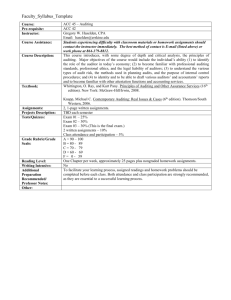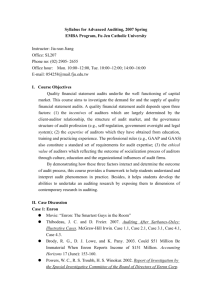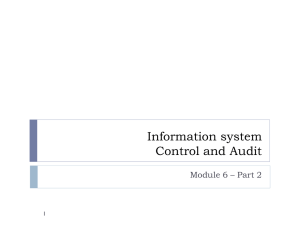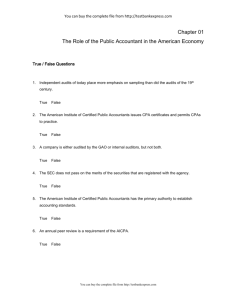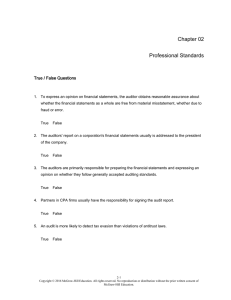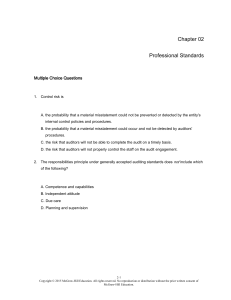Document
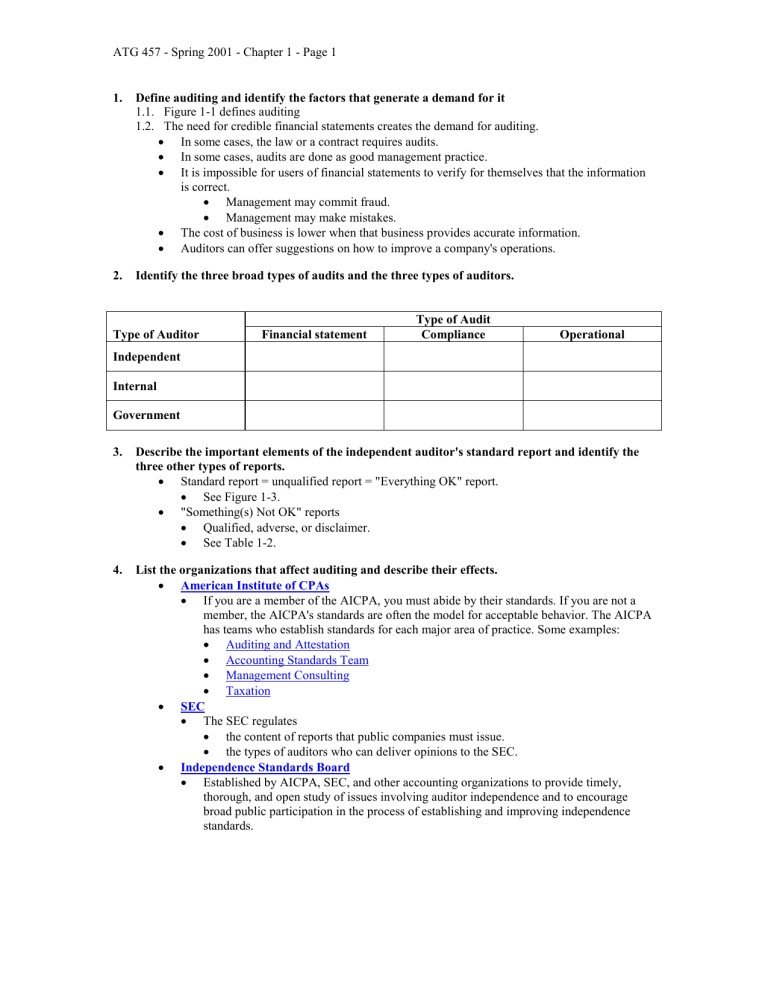
ATG 457 - Spring 2001 - Chapter 1 - Page 1
1.
Define auditing and identify the factors that generate a demand for it
1.1.
Figure 1-1 defines auditing
1.2.
The need for credible financial statements creates the demand for auditing.
In some cases, the law or a contract requires audits.
In some cases, audits are done as good management practice.
It is impossible for users of financial statements to verify for themselves that the information is correct.
Management may commit fraud.
Management may make mistakes.
The cost of business is lower when that business provides accurate information.
Auditors can offer suggestions on how to improve a company's operations.
2.
Identify the three broad types of audits and the three types of auditors.
Type of Auditor Financial statement
Type of Audit
Compliance Operational
Independent
Internal
Government
3.
Describe the important elements of the independent auditor's standard report and identify the three other types of reports.
Standard report = unqualified report = "Everything OK" report.
See Figure 1-3.
"Something(s) Not OK" reports
Qualified, adverse, or disclaimer.
See Table 1-2.
4.
List the organizations that affect auditing and describe their effects.
American Institute of CPAs
If you are a member of the AICPA, you must abide by their standards. If you are not a member, the AICPA's standards are often the model for acceptable behavior. The AICPA has teams who establish standards for each major area of practice. Some examples:
Auditing and Attestation
Accounting Standards Team
Management Consulting
Taxation
SEC
The SEC regulates
the content of reports that public companies must issue.
the types of auditors who can deliver opinions to the SEC.
Independence Standards Board
Established by AICPA, SEC, and other accounting organizations to provide timely, thorough, and open study of issues involving auditor independence and to encourage broad public participation in the process of establishing and improving independence standards.
ATG 457 - Spring 2001 - Chapter 1 - Page 2
State Board of Accountancy
54 state boards
Set requirements to obtain and maintain
certificate
license
Regulate practice
The following organizations influence but to not directly regulate public accounting:
Institute of Internal Auditors
American Accounting Association
Other groups that directly influence:
General Accounting Office
Describes auditing standards for organizations that receive funding from the federal government. These are found in the Yellow Book . For example, auditors must report violations of contract provisions when they are found.
State societies. Organizations like the Illinois CPA Society have standards that their members must follow.
5.
Describe the requirements for becoming a CPA. Note: These requirements vary by state.
Educational requirements
Pass Uniform CPA exam.
Pass ethics exam.
Obtain experience.
Maintain continuing professional education. (CPE)
6.
Discuss the organizational structure within a CPA firm and the services typically offered
Traditional structure:
Partners
Principals
Managers
Senior Accountants
Staff Accountants
Some claim that a diamond or rectangle is replacing the traditional triangle.
Traditional services
Audits of financial statements
Reviews of financial statements
Compilations of financial statements
Tax compliance
Tax planning
Personal financial planning
Consulting
ATG 457 - Spring 2001 - Chapter 1 - Page 3
Nontraditional services
Web Trust
Sys Trust
Elder Care
Other Assurance Services
Contract services
7.
Explain the relationship of auditing standards to auditing procedures
Auditing Standards = Broad concepts.
Auditing Procedures = Specific audit tasks.
8.
Describe the 10 generally accepted auditing standards.
General Standards
I.
Adequate Training and Proficiency
How do auditors obtain training and develop proficiency?
1.
Formal Education
2.
On the job Training
3.
Continuing Professional Education (CPE)
II.
Maintain Independence
Two types of independence are important:
1.
In Fact
2.
In Appearance
III.
Exercise due professional care
Standards of Fieldwork
I.
Adequate planning and supervision
What is adequate planning?
How many auditors to use?
Which personnel to use?
When should audit procedures be performed?
What procedures should be performed?
How many items should be tested?
What is adequate supervision?
Informing assistants of responsibilities.
Directing assistant's efforts.
Reviewing work.
Resolving disagreements.
II.
Obtain understanding of internal control structure
What is the internal control structure?
Why will this be useful to the auditor?
III.
Obtain sufficient competent evidential matter
Sufficient depends on quantity and quality. Auditor needs enough for a reasonable basis for an opinion.
Competence depends on validity and relevance.
Validity - Degree of which evidence supports objective being tested. EG, external evidence more valid than internal evidence. Direct knowledge more valid than indirect knowledge.
Relevance - Degree to which evidence relates to audit objective.
ATG 457 - Spring 2001 - Chapter 1 - Page 4
Standards of Reporting
I.
Report if financial statements are in accordance with GAAP.
II.
State if GAAP has not been consistently applied.
III.
State if disclosures not adequate.
IV.
Express opinion on whole or state an opinion cannot be expressed.
9.
Discuss quality control standards and peer review.
Quality control standards relate to the management of an accounting firm.
Table 1-9 describes the five elements a well-managed accounting firm should have.
Peer review - Every three years an accounting firm hires another accounting firm to "audit" its compliance with Quality Control Standards.
10.
Describe the major types of standards and other authoritative literature that the auditor and public accountant should comply with:
Audits
AU Section of AICPA's Professional Standards
Statements on Auditing Standards (SASs) See Table 1-4.
Interpretations of SASs
Audit and Accounting Guides
Statements of Position of the Auditing Standards
Division
Auditing Procedures Study
Attestation Engagments
AT Section of AICPA's Professional Standards
Statements on Standards for Attestation
Engagements (SSAEs)
Engagements where the accountant issues a written communication about the reliability of an assertion that is the responsibility of another party.
Interpretations of SSAEs
Reviews and Compilations
AR Section of AICPA's Professional Standards
Statements on Standards for Accounting and
Review Services (SSARS)
Interpretations of SSARS
Standards for the compilation and review of financial statements
Quality Control Standards
Quality Control
QC Section of AICPA's Professional Standards
Standards for the management of an accounting firm. Found in the QC section of the AICPA's
Professional Standards.
Peer Review
PR Section of AICPA's Professional Standards
Standards for Performing and Reporting on Peer
Reviews
Standards for review of accounting and auditing practices. Done once every three years. called Quality Review Standards.
Formerly
Professional Conduct
ET Section of AICPA's Professional Standards
Code of Professional Conduct Provides guidance and rules to all members - those in public practice, in government, and in education - in the performance of their professional responsibilities.
Ethics Rulings
Interpretations of the Rules of the Code of
Professional Conduct
ATG 457 - Spring 2001 - Chapter 1 - Page 5
Finally, other professional organizations have standards applicable to their practices. For example:
Standards for management accountants: http://www.imanet.org/content/About_IMA/EthicsCenter/Code_of_Ethics/Ethical_Standards.htm
Standards for internal auditors. This page links to the current standards for internal auditing as well as an exposure draft for revised standards: http://www.theiia.org/guidance/default.htm
